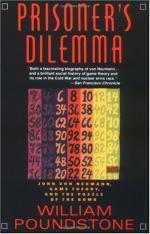
|
| Name: _________________________ | Period: ___________________ |
This test consists of 5 short answer questions, 10 short essay questions, and 1 (of 3) essay topics.
Short Answer Questions
1. As Ohio State subjects were allowed to meet and discuss strategy in the original studies, what strategy dominated play?
2. Many began to see the presumptions of game theory as callous and ___.
3. What is the most popular "solution" to the rational to cooperate in Prisoner's Dilemma as explained in Chapter 11?
4. In what year did the U.S. get good evidence of Soviet nuclear capability?
5. Who became pessimistic about military technology and modern society as they aged?
Short Essay Questions
1. In relation to U.S. bomb development who was Harold Urey?
2. What is backwards induction?
3. Who publicly disavowed preemptive war after publicly advocating for so long?
4. What were the variables of later versions of the Ohio State studies?
5. What is the tit-for-tat strategy?
6. What strategy dominated the original Ohio State studies and the later variations?
7. Who devised the Stag Hunt game?
8. What four games are two-person symmetric as detailed in Chapter 11?
9. What were the Ohio State studies?
10. What game did people think nuclear warfare modeled and why did this change?
Essay Topics
Write an essay for ONE of the following topics:
Essay Topic 1
Chapter 11 details more social dilemmas and outlines differences in two classes of games - symmetric and asymmetric. What is the difference between symmetric and asymmetric games? What are examples of both? How do you play a game of Bully and how is this game a model for human conflict?
Essay Topic 2
How did the strategic thinking of the Cold War become the logic of mathematical game theory as developed by von Neumann and his partner? Who was involved in the Cold War? Who were key players on either side of the conflict?
Essay Topic 3
In 1971 Martin Shubik published the dollar auction in a 1971 paper and is generally credited as the inventor of this game. What was involved in a game called "so long sucker?" Who collaborated on this game and how did it lead to the development of the dollar auction? How does Shubik describe a dollar auction and what makes it different from an auction at Sotheby's? What applications did the dollar auction have to real life and how did the dollar auction embody the non-rational behavior that many expected in game theory games as part of the logic of escalation in conflict?
|
This section contains 758 words (approx. 3 pages at 300 words per page) |

|




